Like many Singaporeans, I’ve been to Japan several times, often sticking to well-worn routes and destinations like Tokyo, Kyoto, and Osaka. I’ve even been to Hiroshima and Fukuoka, so I thought I knew what travelling in Japan was like. It wasn’t until I visited Tohoku, the northeastern region of Japan, that I realised how much more there was to discover.
It turns out, five days in Tohoku was all it took to change my assumptions about what I thought I knew about travelling in Japan, especially in its rural regions.
Also read: Japan’s Best Nature Destinations That Take Your Breath Away: Mountains, Lakes and Hidden Escapes
1. “I thought that getting from Tokyo to other parts of Japan was going to be difficult”
Tokyo is often praised for having one of the best transport systems in the world, thanks to its punctual trains and sprawling subway network. Because of that, I assumed that getting around anywhere outside the capital would be less convenient. But travelling through Tohoku surprised me, from high-speed trains to scenic local rides and even a domestic flight across prefectures. Here’s how it all came together.
The JR EAST PASS covers almost everything
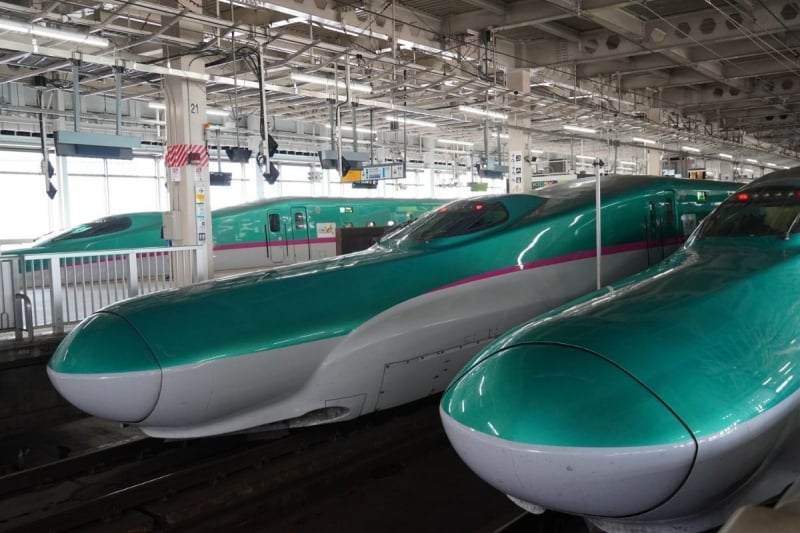
Although we didn’t use it this time, the JR EAST PASS (Tohoku area) is immensely useful for those visiting the area. It can be used to book most local trains in advance, including reserved seats on the Shinkansen. The pass covers major intercity connections as well as regional trains, which means you won’t have to stress about buying tickets at every stop. It’s incredibly convenient and cost-effective for travelling across multiple prefectures in Tohoku!
Scenic trains were part of the journey
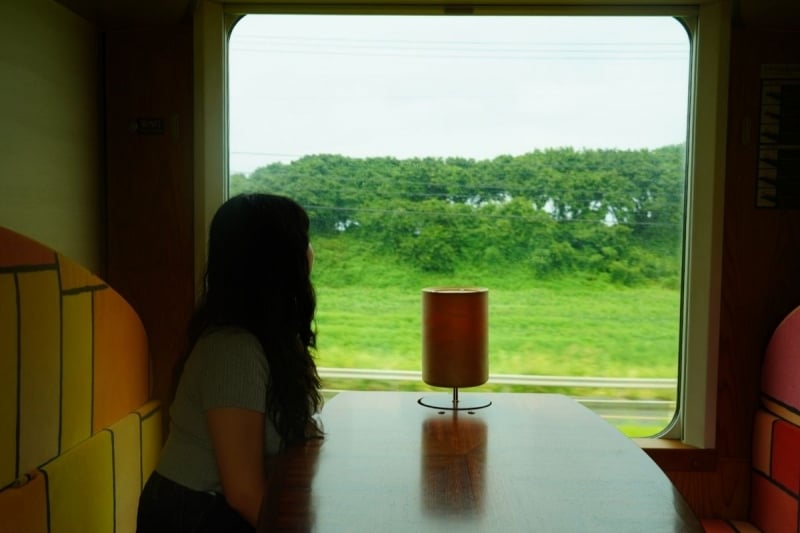
One of the most memorable rides was on the Resort Shirakami, a sightseeing train with panoramic windows that runs along the Gono Line between Aomori and Akita. The route hugs the coastline, passing through tunnels, forests, and cliffside views of the Sea of Japan. Inside, there were even live performances (we had a shamisen musician playing while the landscape rolled by).
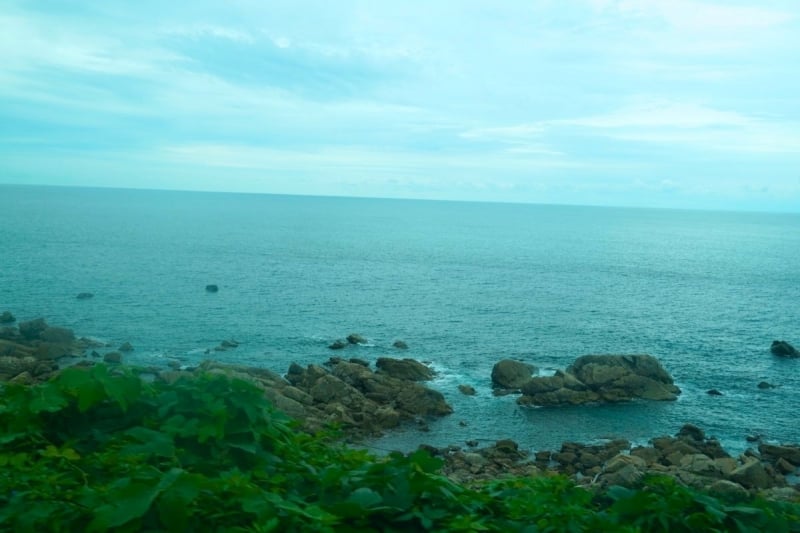
Tripzilla Tip: The Resort Shirakami is covered by the JR East pass, but you need to make your booking in advance. Bookings open one month before the departure.
Domestic flights were easy and efficient

To get back to Tokyo from Akita, we took a short domestic flight. Check-in was smooth, security was fast, and the flight itself took just over an hour. For travellers who want to start or end their Tohoku trip with a flight, it’s a good reminder that rural doesn’t have to mean remote.
2. “I thought Tohoku only had nature-related activities.”
When I first imagined Tohoku, I pictured scenic mountains and quiet countryside. Beautiful, but mostly suited for nature lovers. What I found instead was a region full of variety, from art and culture to anime and hands-on activities. There’s something for every kind of traveller. In just five days, I was already able to do so much and yet, I think I only managed to scratch the surface of Tohoku. Here’s a glimpse of what different kinds of travellers can look forward to.
For anime lovers
Haikyu!! Photo Spot, Miyagi
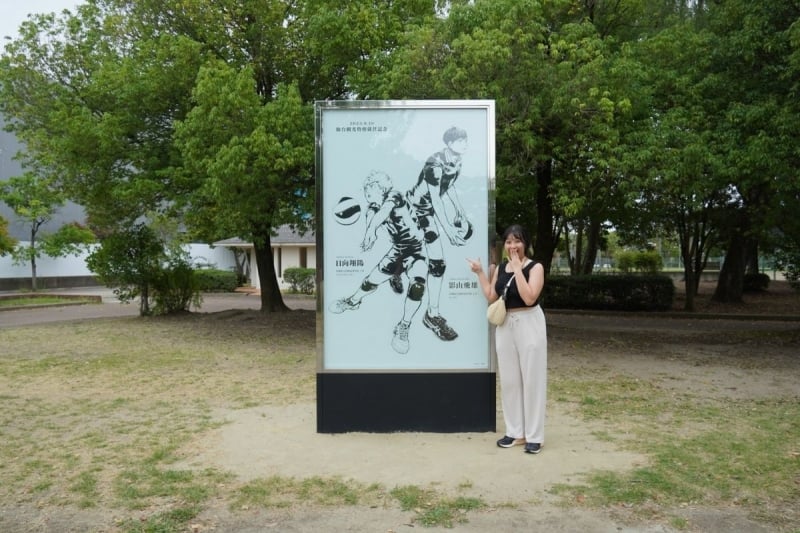
Whether you’re a long-time fan or just got into Haikyu!!, standing where it all began hits different. Tomizawa Park, located in Sendai, is home to the Haikyu!! Monument.
It is just next door to Kamei Arena Sendai, where the Miyagi Prefectural Playoffs took place in the anime. The arena itself is currently closed for renovations, but I still found myself grinning like an idiot just being there. After nearly ten years of loving Haikyu!!, it felt surreal to be so close to the world I’d spent so much time in.
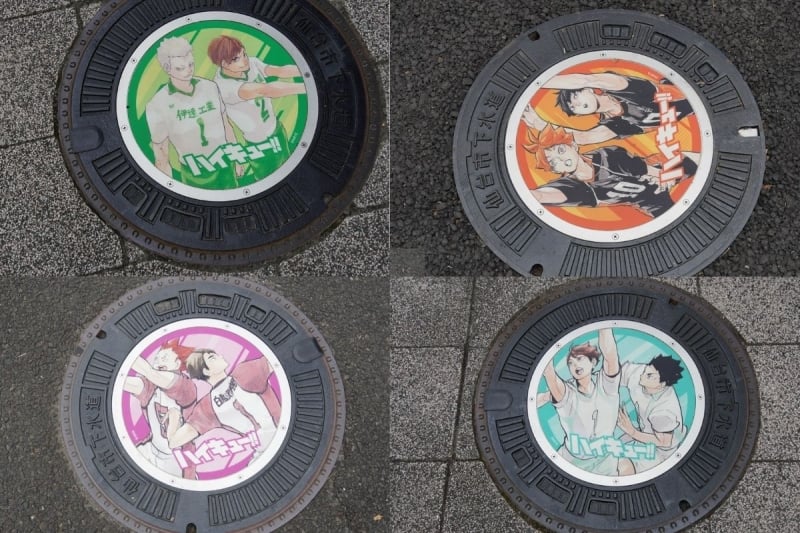
Don’t miss the 4 Haikyu!!-themed manhole covers, which are located nearby. You can find the exact locations via the Sendai City website or refer to the map below.
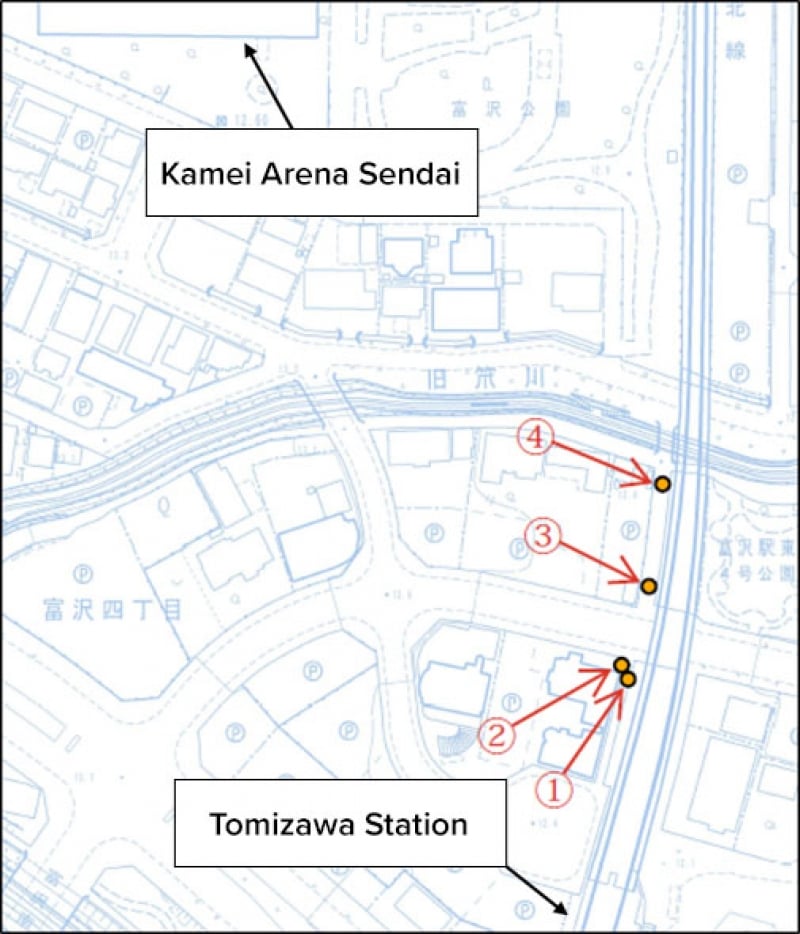
Image credit: Sendai City Website | Map by JNTO Singapore
Ocha no Igeta (Sendai Chuo Main Store), Miyagi

If you’re a Jujutsu Kaisen fan, you might recognise this one. In the anime, Satoru Gojo visits a real-life souvenir shop in Sendai to buy Kikufuku Manju, a soft mochi filled with zunda cream. Zunda is made from mashed edamame, but sweetened into a smooth, earthy paste.

The shop has become a bit of a pilgrimage spot thanks to Gojo’s visit. I tried both the Kikufuku Manju and the zunda shake, and really enjoyed them. The mochi had a soft, almost stretchy texture that paired surprisingly well with the gentle sweetness of the filling. There’s also an eat-in space inside, so you can rest and enjoy your snack while soaking in the atmosphere.
Other anime pilgrimage spots
Though we didn’t get to go ourselves, Shirakami Sanchi, a UNESCO World Heritage Site spanning Aomori and Akita, is said to have inspired the mystical forest landscapes in Princess Mononoke. The seasons there change the colours of the mountain dramatically, making it a beautiful and meaningful addition for Ghibli fans planning their own route.
Other anime pilgrimage spots in Tohoku are just as compelling. Ginzan Onsen, with its wooden ryokan and quiet river views, is often linked to the setting of Spirited Away. Over in Aizu City, a traditional ryokan is believed to have inspired the design of Demon Slayer‘s Infinity Castle. Your Name fans might also want to stop by Maeda-Minami Station, which is often said to resemble the fictional Itomori Station.
Together with places like Tomizawa Park and Ocha no Igeta, these stops form a rich pilgrimage trail across the region. It’s a meaningful way for anime lovers to explore Tohoku through the stories they love.
For hands-on travellers
Kitakami River Cruise, Iwate
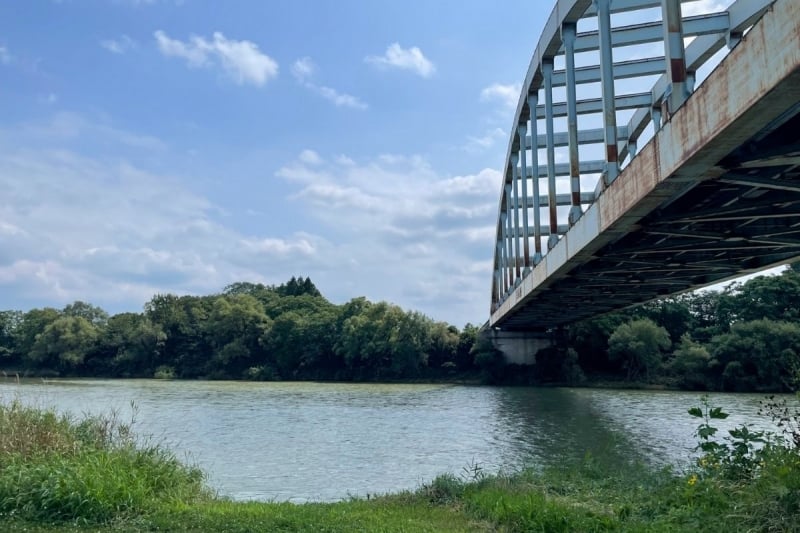
The Kitakami River is the fourth largest in Japan, and has long been more than just a scenic waterway. It once served as a vital transport route, carrying rice and other crops from inland towns to Sendai.

When we went, it was the height of summer. The water was cool against the heat, and there was something deeply peaceful about drifting with the current, sipping tea and nibbling on cookies in the raft. At times, the river sped up just enough to feel exciting, which made the experience both calming and energising.
If you’re visiting Tohoku in the summer, this is something I’d really recommend. It felt like such a quintessential ‘summer in Japan’ moment, and it was easily one of my favourite moments in the trip!
Tsugaru Yume Apple Farm, Aomori
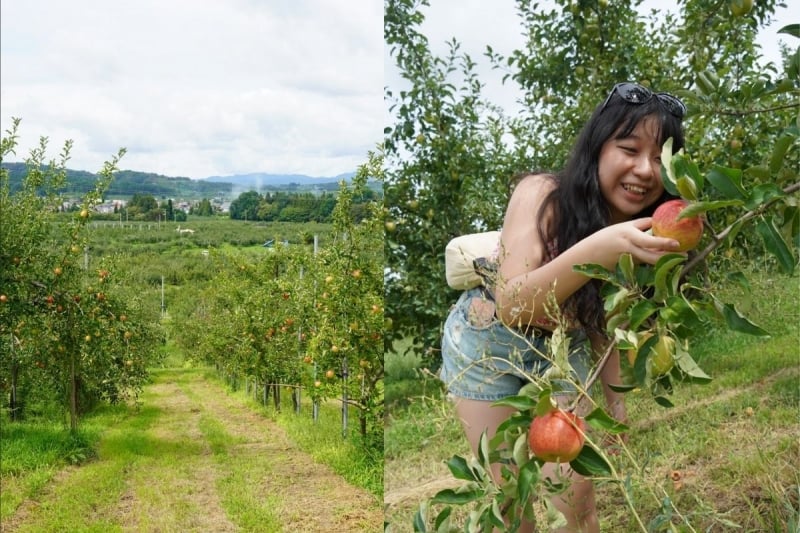
Many apple farmers today came from samurai families, while the people who made their apple cutters once forged katanas.
Aomori is known across Japan as the City of Apples. The prefecture produces around 60% of Japan’s domestic apples, and there’s real history behind the orchards too.
After the Meiji Restoration ended the samurai era, many of the samurai families in this region turned to apple farming to make a living, giving these farms a quiet legacy of resilience.
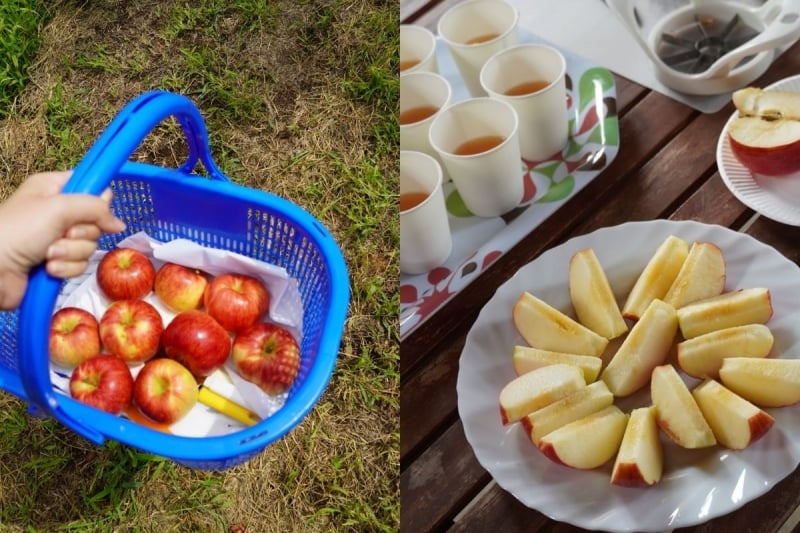
We visited the farm in summer, slightly before peak apple season, so the trees weren’t in full bloom. Still, we managed to pick a few, and the taste honestly caught me off guard. The apples were so juicy, it felt more like drinking nectar than eating fruit. By the end of it, I was really wishing I could’ve brought home a basket of apples with me.
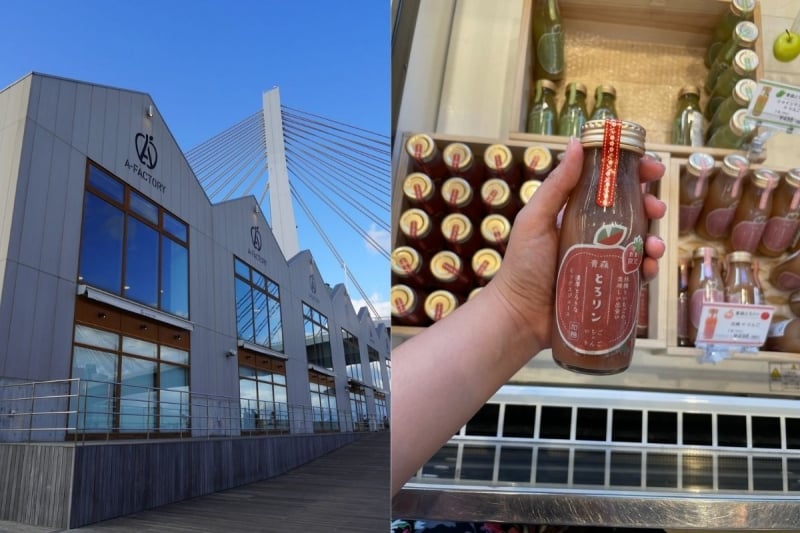
A-FACTORY is right outside Aomori station, making it a perfect first (or last stop) if you’re visiting Aomori.
While that wasn’t exactly possible, I did stop by A-FACTORY (a market-style shopping centre) to pick up some apple-themed snacks for my family. They sell apples in just about every form you can think of, from pies and brownies to jams and cider.
Also read: Top 30 Tokyo Souvenirs in 2025 & Where to Get Them on Your Next Trip
IRODORI Lantern-Making Workshop, Aomori
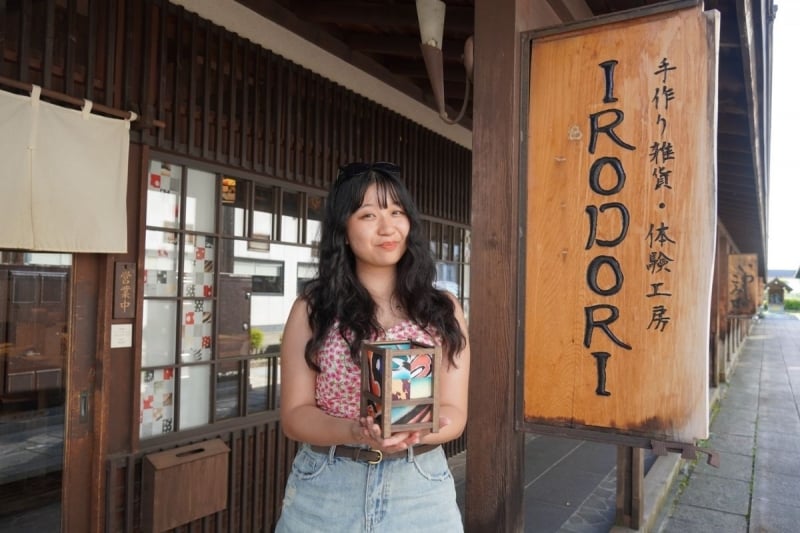
On Nakamachi Komise Street in Kuroishi City, a beautifully preserved stretch of traditional buildings, you’ll find IRODORI, a small craft workshop that gives new life to Aomori’s iconic Neputa floats. Here, you can make your own Japanese lantern using real fragments of Neputa paintings that were once used in actual festivals.

The materials are recycled from previous years’ floats, so nothing goes to waste.
Each piece is unique, and you get to pick the colours and patterns you like best. I really enjoyed slowly selecting the pieces, because it made the lantern into a very personal keepsake.
Later in the trip, we visited a museum that showcased full-scale Neputa floats, which helped me appreciate just how special this experience was. I’ll share more about that later, but this workshop was a lovely way to connect with tradition in a hands-on and creative way.
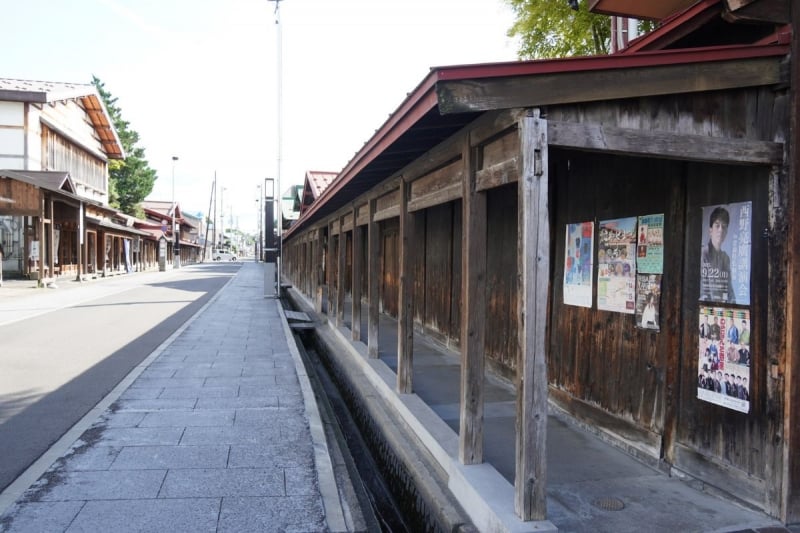
After the workshop, we wandered further down Komise Street. Originally built to shield locals from heavy snow, it’s now lined with wooden merchant houses that have stood for centuries, making for a quiet showcase of how people in snowy Aomori adapted to their surroundings.
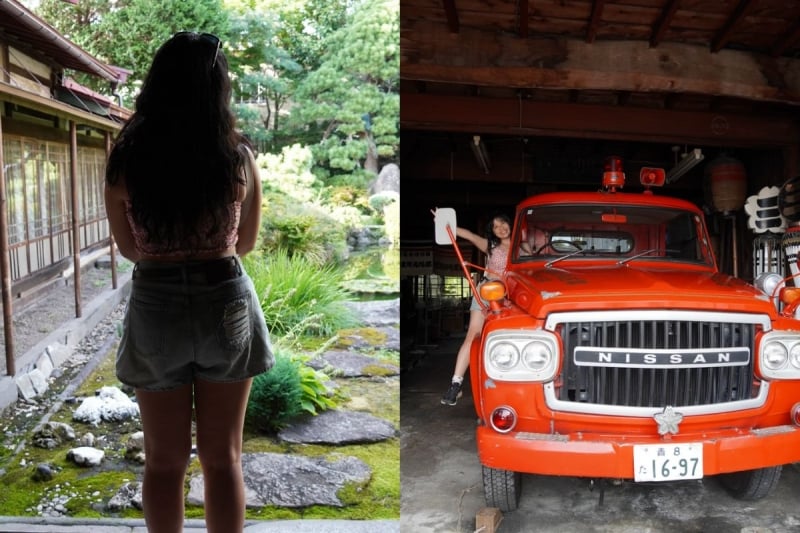
Along the way, we passed some interesting spots, like a Japanese garden tucked in the home of a historical sake brewing family, and even Japan’s oldest active fire truck tucked into a garage.
For cultural explorers
The Nebuta Museum WA-RASSE, Aomori
If you’re visiting Aomori, the Nebuta WA-RASSE Museum offers one of the best ways to experience the vibrant energy of the Aomori Nebuta Festival, even if you’re not in town for the actual event. Originally created to drive away both drowsiness and evil spirits during the farming season, the festival has grown into one of Japan’s most spirited celebrations.
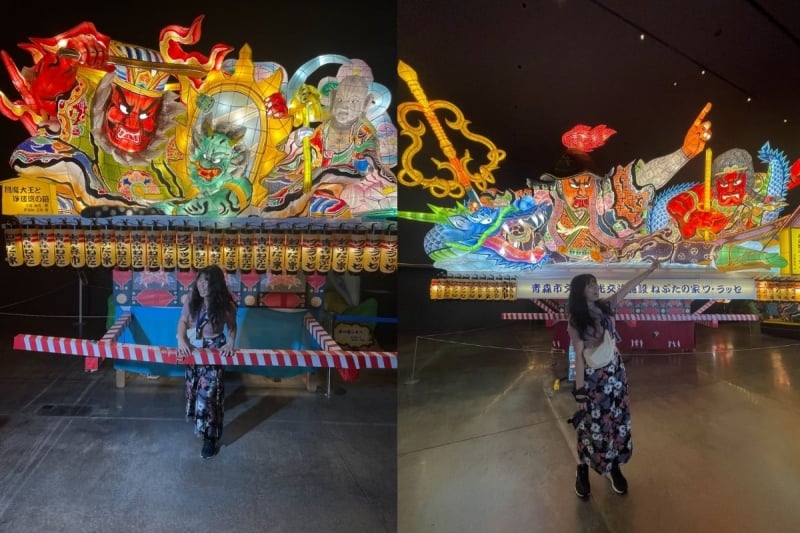
The museum brings this energy to life through its exhibits. One highlight is the darkened main hall, which displays four full-sized Nebuta floats from previous years. These are changed out annually, so every visit offers something new. I was struck by the level of detail and craftsmanship in each float. It felt like walking through a living memory of the festival, surrounded by colour, light, and sound.
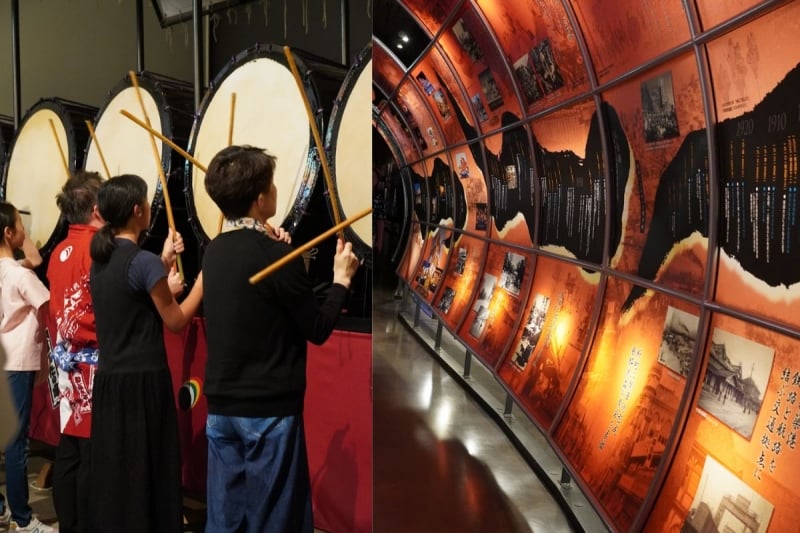
There are hands-on experiences too, including the chance to play the taiko drums or join in a Haneto dance session.
Tsugaru-han Neputa Village, Aomori

If you’re curious about how Nebuta varies across regions, Hirosaki offers a great window into these differences. Here, it’s known as Neputa instead of Nebuta, due to local dialect.
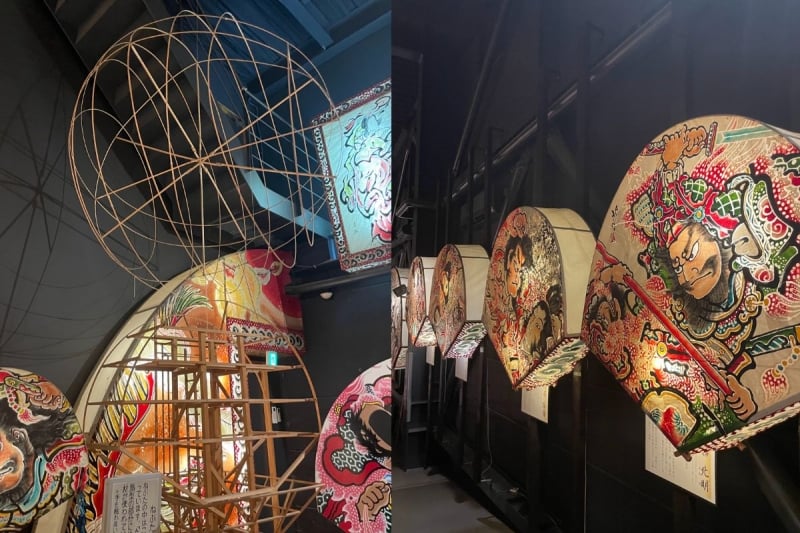
At Neputa Han Village, you’ll learn how the floats are made differently. In Hirosaki, most floats are shaped like fans, and the festival is deeply rooted in community involvement rather than government funding. The wooden frames are reused, while new designs are created every year. Because the process is community-led, the designs often change from year to year depending on the support and resources available.

As someone deeply interested in the culture and heritage of the places I visit, I really appreciated being able to get a glimpse into the cultural richness that makes Nebuta so special across Tohoku.
Roadside Station Ishido-riya, Iwate
We also stopped by the Nambu Toji no Sato, a small heritage centre dedicated to the traditional sake brewing culture of the Nambu Toji.
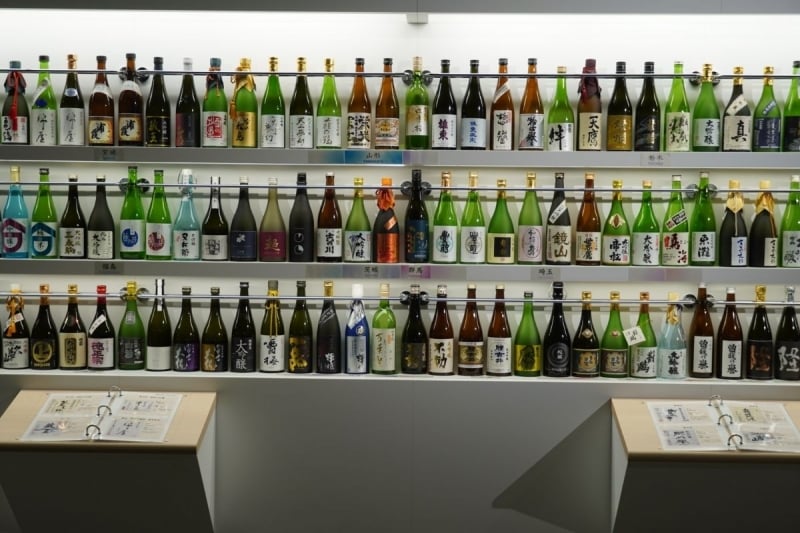
Inside, there’s an English-language screening that gives a great introduction to the unique brewing techniques passed down by Nambu master brewers.
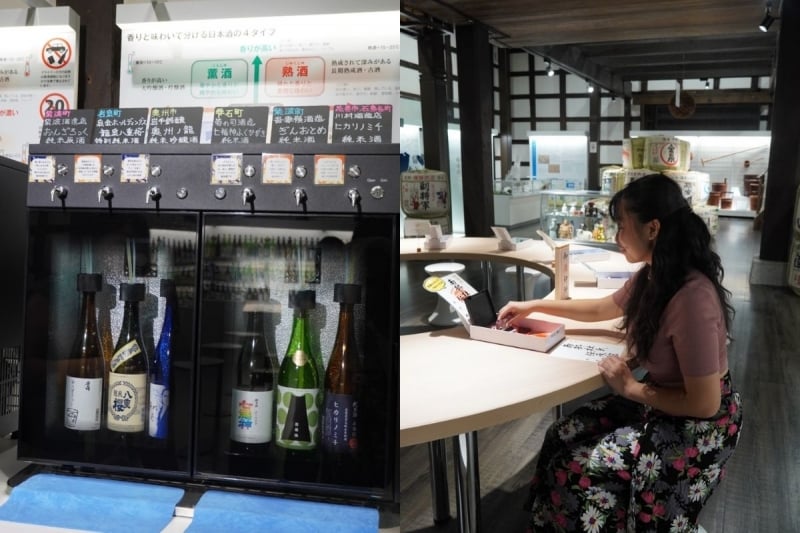
You can also enjoy a sake tasting experience and learn to pick up on the subtle differences between each brew. There was even a goshuin station for you to customise and bring back a personalised souvenir!
After the museum visit, head next door to the souvenir shop, where you’ll find all kinds of sake-themed treats, from sake cakes to sake-flavoured ice cream. Nothing like a little something extra to spice up your desserts.
Namahage Museum, Akita
Another one of the most fascinating cultural experiences we had was visiting the Namahage Museum in Oga, Akita. Namahage are traditional visiting deities who appear during New Year’s eve to ward off misfortune and evil, pray for good health and safety for the family, and a good harvest for the new year. The practice dates back to before the feudal period and was recognised by UNESCO as an Intangible Cultural Heritage in 2018.
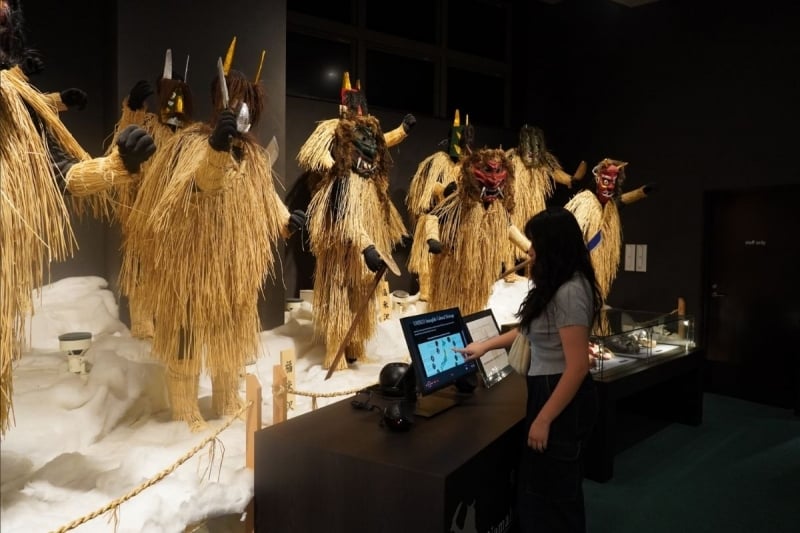
Each region in Oga has its own unique Namahage mask and costume, and I saw over 150 unique masks displayed in the museum! There’s even a spot where you can try on a Namahage costume and snap a photo.
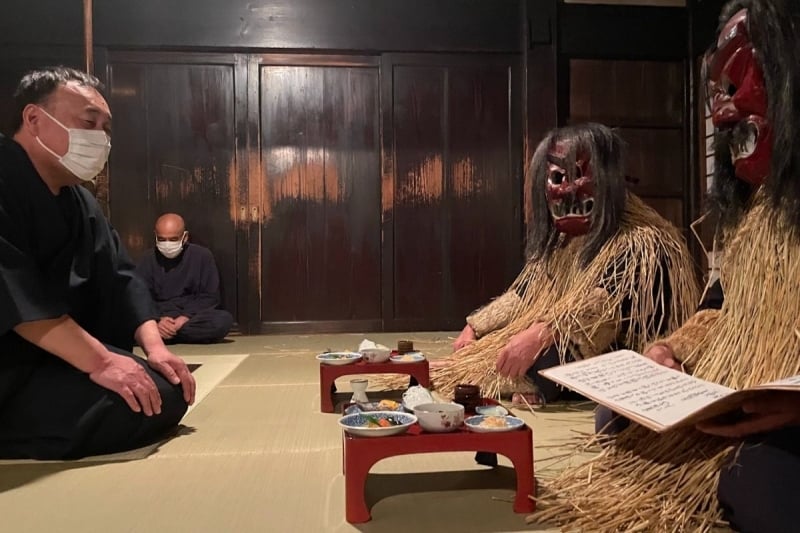
But the most memorable moment for me was the live performance reenacting how the Namahage enter a house. It was very immersive and a little intimidating, but I found it to be a meaningful and engaging way to connect with the local folklore.
For slow wanderers
Kanrantei Teahouse, Miyagi
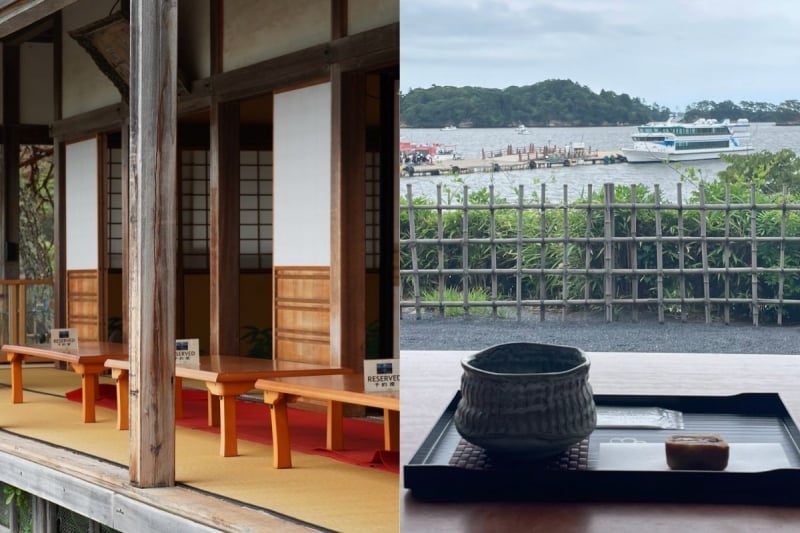
We visited Kanrantei Teahouse, which was once gifted to the area’s feudal lord at the time by Toyotomi Hideyoshi. It used to serve samurai and high-ranking guests, and now welcomes quiet wanderers like us.
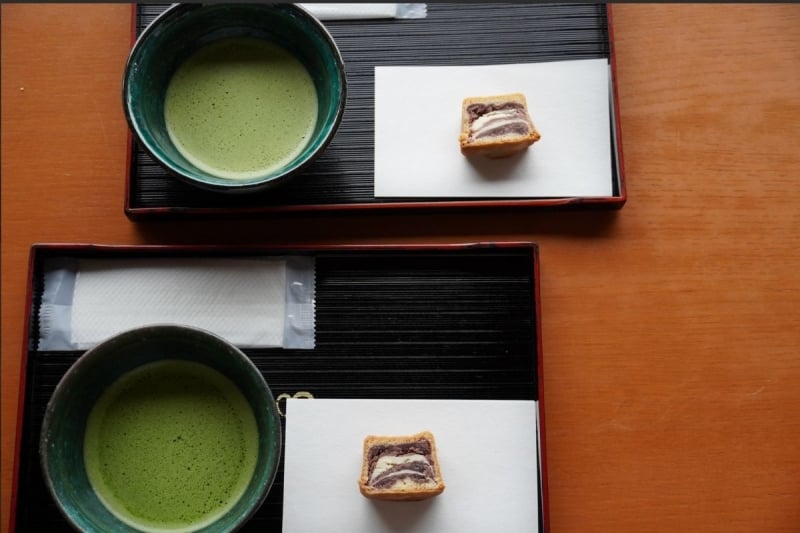
There were sweeping views of Matsushima Bay, and we sat by the window sipping matcha and watching the boats pass through the pine tree-covered islands. I was living the definition of a zen life here.
Matsushima Shima meguri, Miyagi
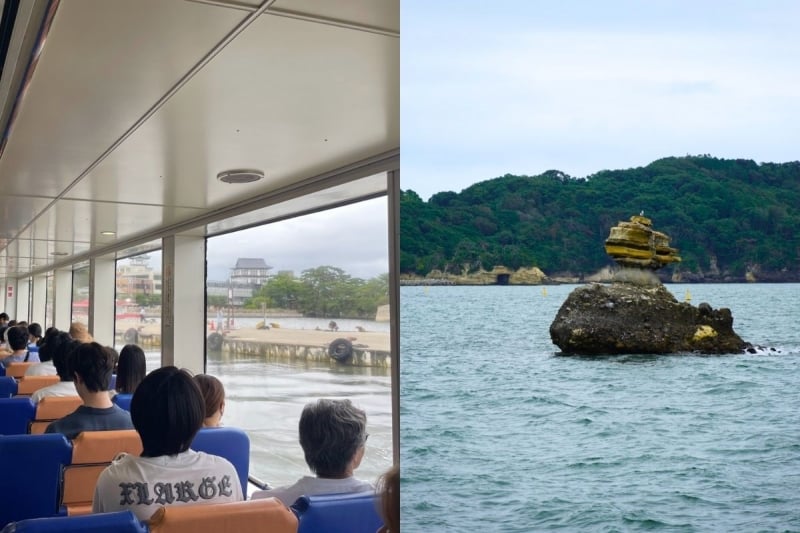
Cruise routes vary depending on whether you want to disembark and walk around the islands, but the classic ride starts and ends at the same port.
But to really appreciate the beauty of Matsushima, a bay cruise is a must. The ride takes about 50 minutes and loops around over 260 small islands, shaped over 20,000 years by geological shifts. Their positioning forms a kind of natural seawall, which once helped protect the coastline from the full force of a tsunami.
If you’re heading there in April, cherry blossom season makes it even more magical. Autumn is also a popular time, with vibrant foliage peeking out between the pines.
Koiwai Farm, Iwate
We also stopped by Koiwai Farm, one of Japan’s largest private farms, located at the base of Mount Iwate. Even if you’re not usually into farm visits, this place is worth it for the views alone. The rolling fields, grazing cows, and buildings look straight out of a Wes Anderson film!
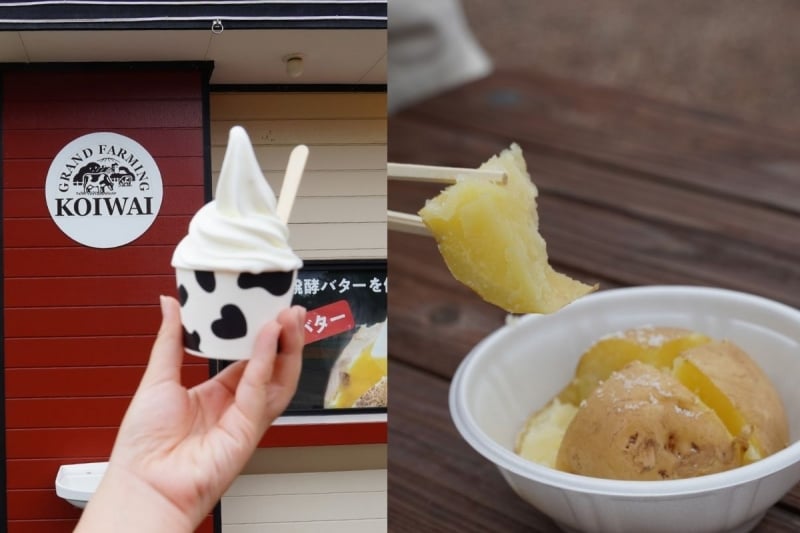
Their soft-serve ice cream, made with fresh milk from the farm, was unbelievably creamy. I also tried the buttered potato, made with their very own fermented butter. Fresh produce is on another level…I highly recommend both if you stop by!

I love horses, so I was super excited to find out that you could also go horseback riding there. Do note that the circuit is more of a short stroll suited for beginners, though! You can also feed animals or just stroll around Makiba Park and soak in the scenery.
Also read: Where to Go in Japan: The Most Popular Travel Routes Explained
Inakadate Village Rice Paddy Art, Aomori
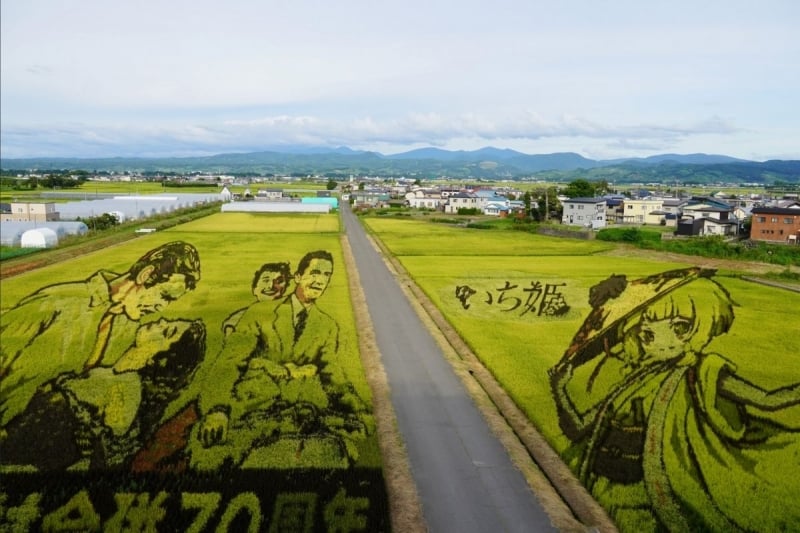
After wandering the Komise Street area, we made our way to Inakadate Village, best known for its rice paddy art. Every year, the locals transform rice fields into massive living murals using different coloured rice strains. Past years have included portraits, historical scenes, and even movie posters.
We climbed a small tower to take in the full mural and were genuinely blown away. When I saw the full scale of it, it dawned on me the scale of human effort behind it. It was jaw-dropping, to say the least.
Selion Tower, Akita

We made a quick stop at Selion Tower, which has a free observation deck overlooking the city and coastline. It wasn’t a long visit, but the view was clean and wide, with the sea on one side and Akita’s skyline on the other.
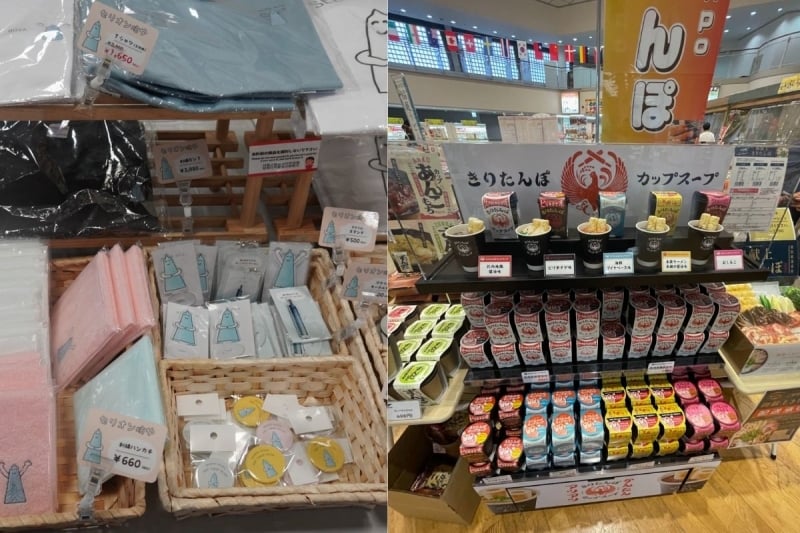
Below the tower, there’s a local produce market and souvenir shop. You can pick up some of Akita’s local specialities (which include iburigakko, Inaniwa udon, and kiritanpo), or even some merch of Selion Tower itself (trust the Japanese to make the cutest merch).
3.“I thought I knew Japanese cuisine.”
If you’ve ever looked into regional food culture in Japan, you’ll know just how localised Japanese cuisine really is, beyond the typical sushi and ramen dishes. Each prefecture has its own seasonal specialities and flavour preferences. Tohoku’s cuisine was both diverse and absolutely delicious, and I realised that what I’d thought I’d known before turned out to be just a sliver of a much richer culinary landscape in Japan.
Miyagi
Gyūtan (beef tongue) at Gyūtan Cuisine Kaku, Nagake-cho Store

You can’t go to Sendai and not try gyūtan. Some say that the dish was invented here after the war, and one theory traces it back to a local restaurant owner who, after sourcing beef tongue from an American base, decided to grill it and turn it into a specialty.
We had ours at a speciality spot where the slices were grilled just enough to stay juicy, with a light char that brought out their umami. It’s tender, and best eaten with barley rice and oxtail soup.
Local dinner at Ganso Robata

This was a standout not just for the food, but for the whole experience. Here, you can taste local dishes passed to you using long wooden paddles.
The speed of the handoff and the attention to presentation made the meal feel more like a performance. It’s hard for me to choose a standout dish amongst the almost 11-course meal we had because each one of them was prepared so meticulously and was of top quality. I also felt like the experience was very seamless, with one dish perfectly transitioning into the next one.
Bar-hopping in yokocho alleys

After dinner, we wandered through one of Sendai’s narrow yokocho alleyways filled with tiny bars and izakayas. Most could only seat a handful of people, with some being standing bars, but each had its own vibe. We ducked into one for highballs and oysters, squeezing elbow-to-elbow with locals. Bar-hopping after dinner felt like such an authentically Japanese moment!
Iwate
Wanko soba at Yamanekoken
We tried this in Morioka, where the wanko soba challenge is a bit of a rite of passage. Servers cheer you on with lively chants of “Hai jan jan! Hai don don!” as they quickly refill your bowl, one bite of soba at a time. Every bowl is meant to be eaten in one gulp, which somehow makes 40 bowls feel like a light lunch. The experience ends only when you cover your bowl to signal you’re done. Rooted in the Iwate omotenashi (Japanese hospitality) spirit, wanko soba is all about serving with generosity and making sure guests can eat to their heart’s content.
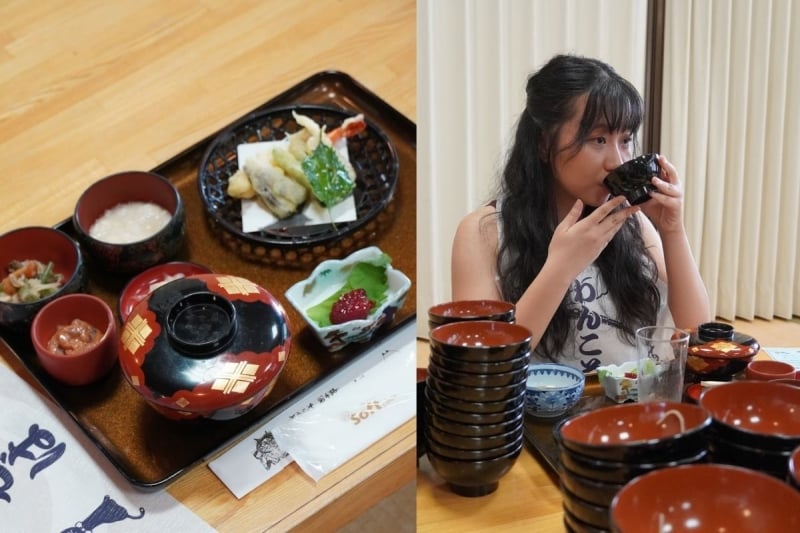
There are also many different ‘toppings’ meant to change the flavour of the soba, such as tororo (grated yam), and ebi. Between the playful exchanges with the server, where she cheekily slips more soba into your bowl before you can stop her, and changing the flavour of the soba by pairing it with different ingredients, dining became gamified. It was such a unique experience, and I thought it was such a fun way to get a taste (literally!) of local culture through their cuisine.
Morioka reimen at Sanroku-kan Restaurant
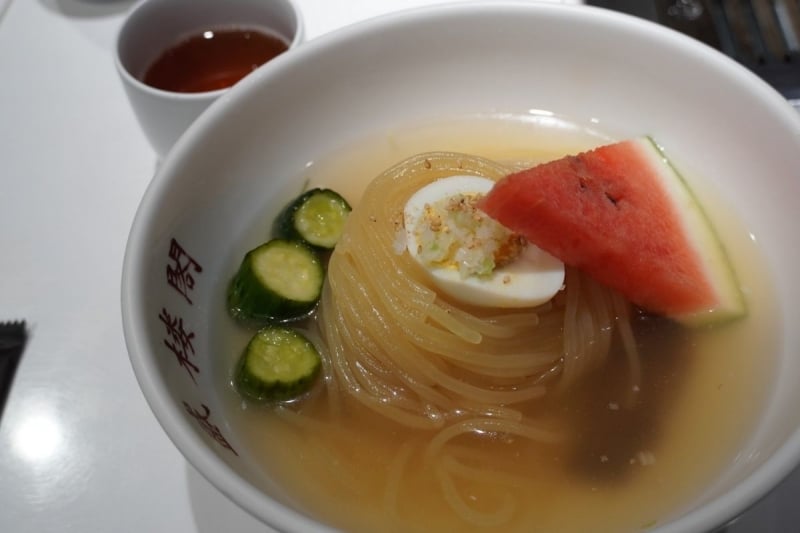
We also tried morioka reimen, a cold noodle dish that originated from Korean immigrants in the area and has since become a local favourite. The broth is icy, light, and slightly spicy, served with chewy noodles, kimchi, and seasonal fruit like watermelon or pear.
I was also pretty surprised to see watermelon being served in a savoury dish, but it paired really well with the noodles. The saltiness of the broth didn’t seep into the watermelon, and it retained its sweetness.
This dish was refreshing and easy to swallow, making it a perfect dish for the summer.
Maesawa Beef Kaiseki Dinner at Hotel Kashoen

Now this was a meal that oozed luxury. The kaiseki course that we had in a ryokan featured regional specialities like Maesawa beef (beautifully marbled and melt-in-your-mouth tender) alongside delicate seasonal dishes that felt more like art than food.
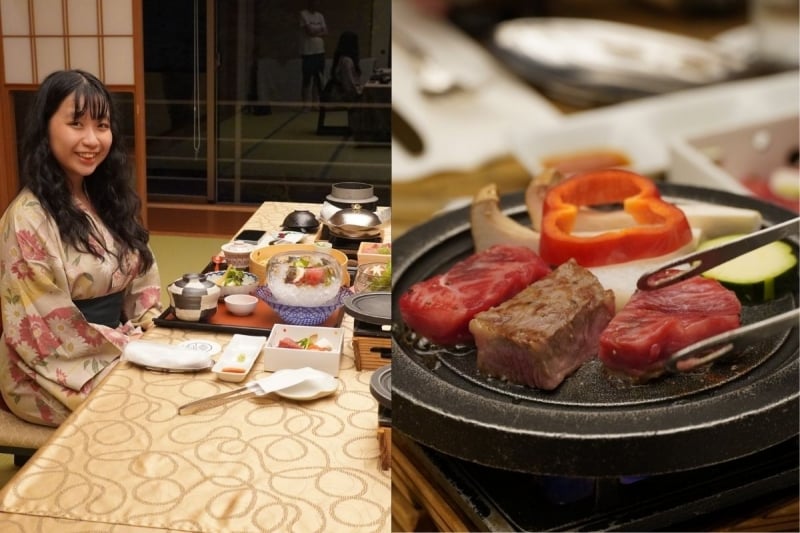
Everything was served with meticulous care and precision that made the meal feel special without being over-the-top. And the presentation of the dishes was absolutely beautiful. I almost didn’t dare dig in for fear of ruining it!
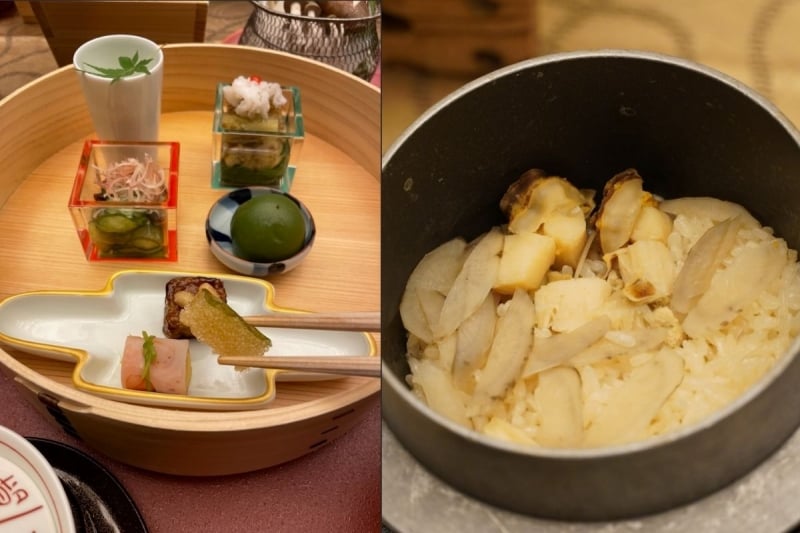
But I’m glad I did. Every dish was a new discovery of flavour, and I felt a sense of wonderment with every lid I opened or every bite I took.
Aomori
Kaiyaki Miso at Neputa Umamiya

Kaiyaki Miso is Aomori’s take on scallops. It’s grilled right in the shell with a miso-based sauce. You pour in raw egg when the scallop starts to boil, and eat it together. The dish reminded me a little of oyakodon with the pairing of savoury meat and egg, but it’s tender scallops instead of chicken.
Something about the kaiyaki miso tasted familiar even though I’d never had it before, and I suspect it has something to do with the taste of home.
KAI Tsugaru’s Special Maguro (Tuna) Course
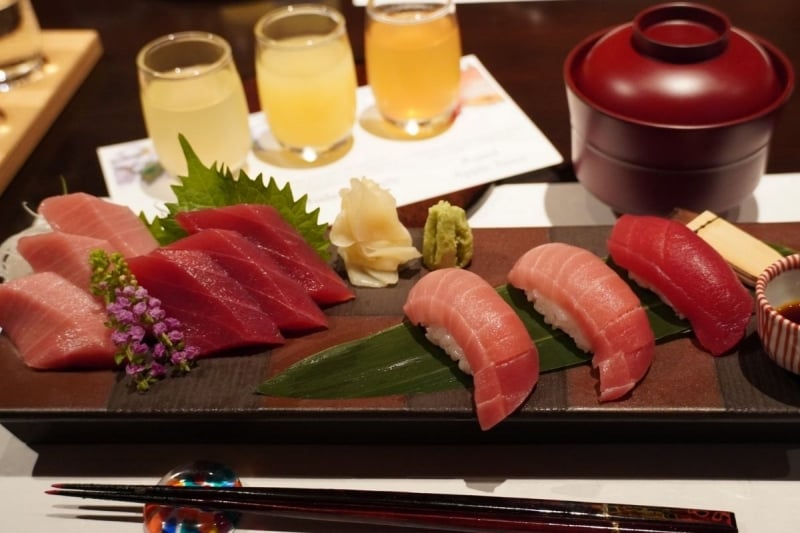
We had dinner at KAI Tsugaru, and got to try their special maguro course. Tuna caught off the Tsugaru coast is prized for its fat content and freshness, and we got to try it in a few different ways – sashimi, marinated, and grilled. Each preparation brought out a different texture and flavour, and it was clear how much care went into handling the fish.
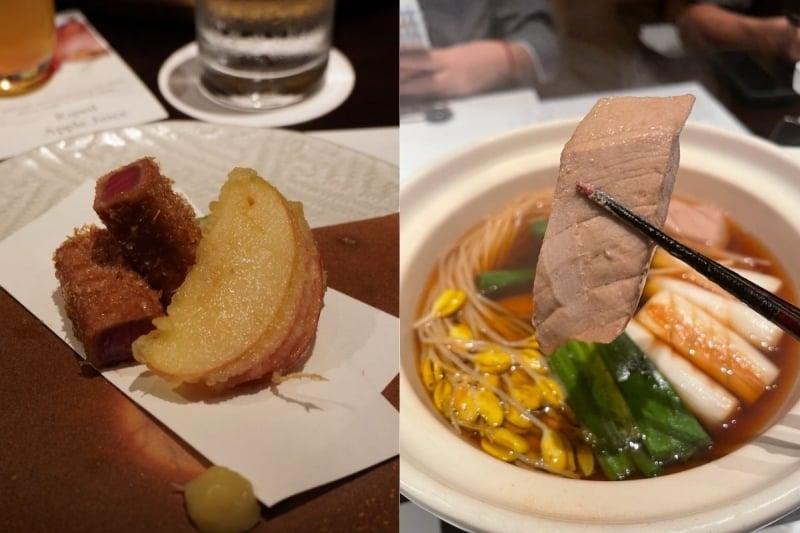
I wasn’t the biggest fan of sashimi before coming here, but I realised how big a difference ‘top-grade quality’ would make. The fresh tuna had a subtle taste that paired well with soy sauce, and I was absolutely feasting during this dinner.
Hotel ReLabo’s Aomori French Gastronomy
We also got to try a wellness-focused gastronomy at Hotel ReLabo. This dinner features Aomori French cuisine reconstructed with a scientific approach using fresh local ingredients.
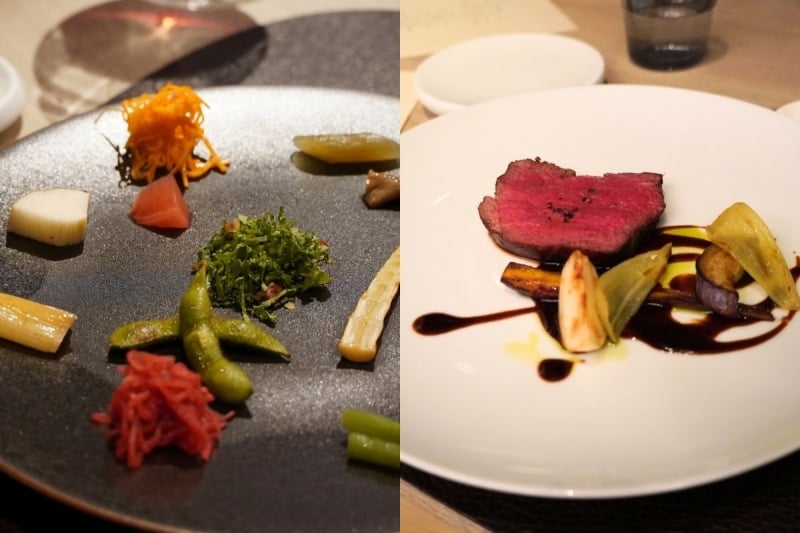
I noticed that it was all prepared without heavy seasoning, so the produce could speak for itself. But the main star of the night, to me, had to be the beef, which was meticulously maintained at 55 degrees to cook the inside before the outside was grilled. It melted in my mouth, and I really wished I could erase my memory so I could try it for the first time again.
This was a meal that was quietly nourishing, and it made me think differently about what ‘luxury’ in food could mean.
Akita
Horse meat at Restaurant Sakuratei
This was one of the more adventurous meals of the trip. At Sakura-tei, we tried horse meat, a regional speciality that’s lean, tender, and served both raw (like sashimi) and grilled.

It’s not something I’d ever imagined trying, but the experience was memorable, and handled with a lot of respect and care for the ingredients.
Inaniwa Udon & Iburigakko at Inaniwa Honpo Meiji Sasuke Shoten, Akita Airport
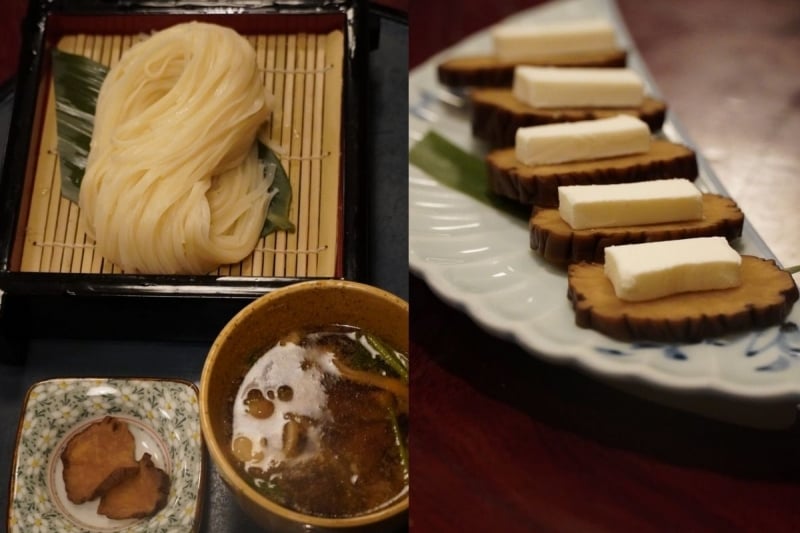
Akita is known for its iburigakko (smoked radish), which has a savoury, almost bacon-like flavour. We picked some up as a side dish for our last dinner. It’s a simple but intensely satisfying local flavour, and unlike anything I’ve had elsewhere in Japan.
As for our main course, we tried inaniwa udon, another Akita local speciality. The noodles are hand-stretched, thinner and silkier than regular udon, and served cold with a dipping sauce. This was the last meal we had before our flight back at Akita airport, and it made for the perfect farewell.
4. “I thought it’d be hard to find luxurious stays outside the major cities of Japan.”
I used to think that if you wanted luxury in Japan, you had to stick to the cities like Tokyo, Kyoto, or maybe a few upscale spots in Hokkaido. But I was proven so wrong. The hotels we stayed in were so comfortable and thoughtfully designed, rich in local character, and offered the kind of care and attention characteristic of Japanese hospitality.
Hotel Kashoen, Iwate
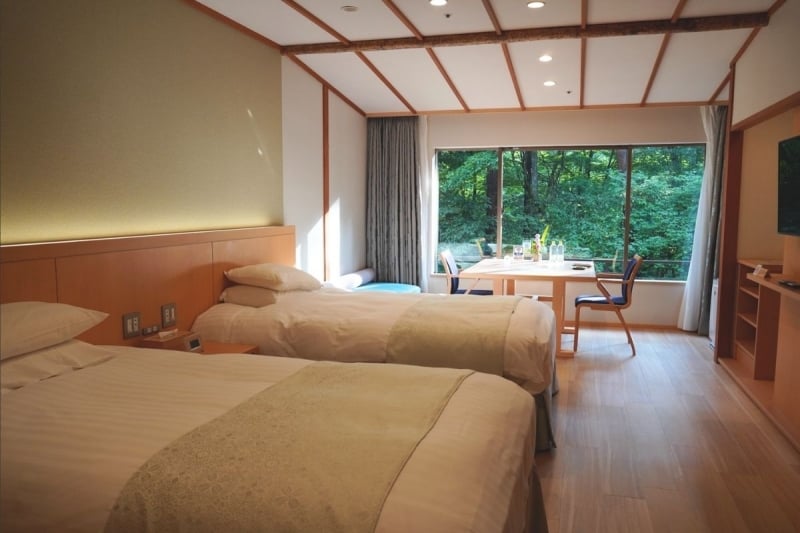
Tucked away in Hanamaki Onsen Village, Hotel Kashoen felt like stepping into another time. The ryokan-style interiors were elegant without being overdone, and the hospitality was so warm.
What stood out most to me was the attention to detail, from the carefully prepared kaiseki dinner (see above) to the private onsen that overlooked a garden wrapped in summer green.
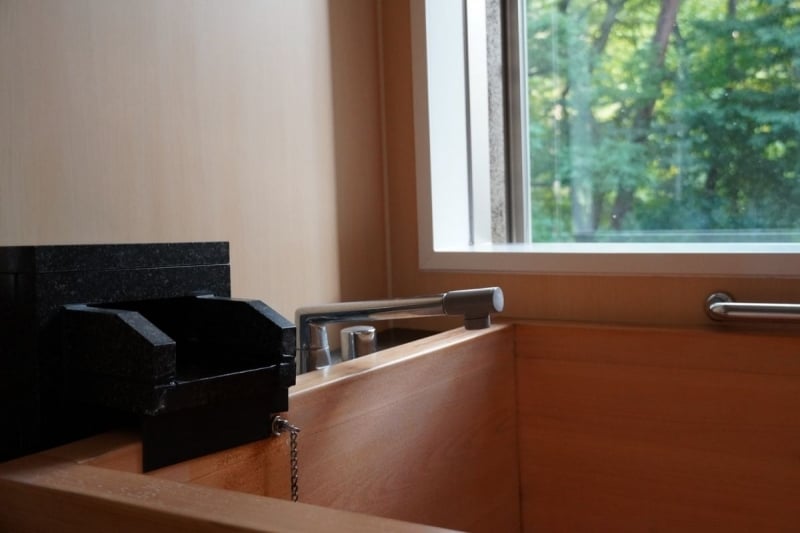
The onsen water itself boasts a ph of 9, giving it beneficial properties for the skin. I thought that the variety of shampoos and soaps offered at the public onsen was an added bonus!
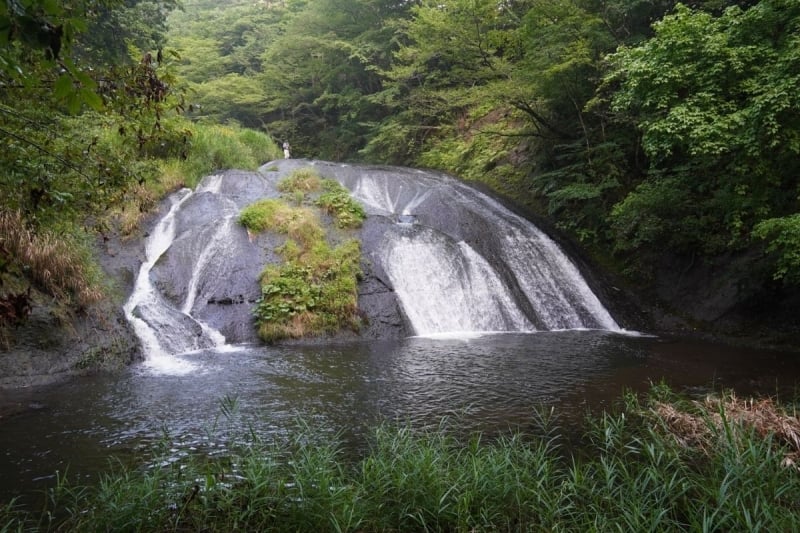
We also visited Kamabuchi Falls, which were just behind the ryokan. Growing up watching Princess Mononoke, I’d always been quite privy to the idea of mythical forests…and Kamabuchi Falls felt just like that.
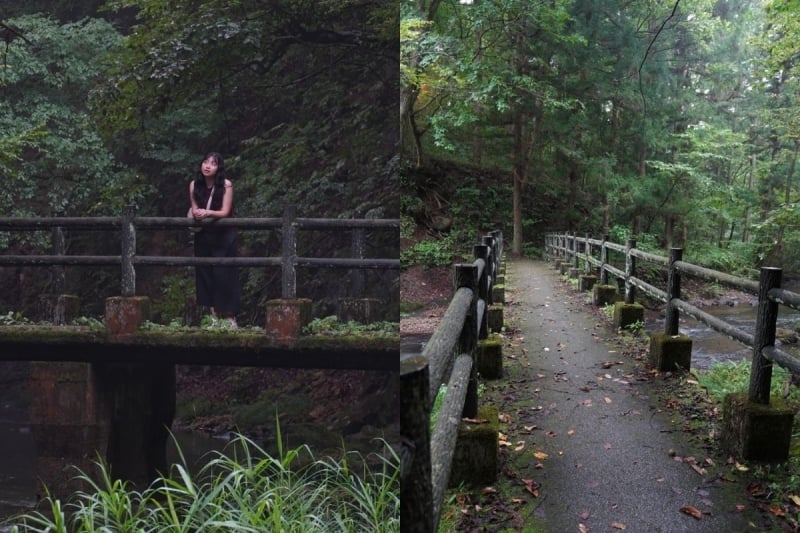
Something about it felt tucked away and private, as if this was a space for just me to roam around.
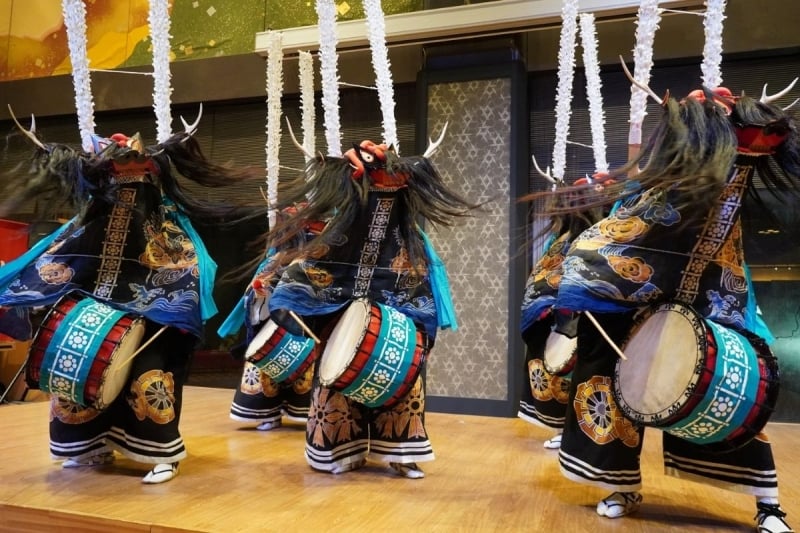
After dinner, we were treated to a shishi-odori (deer dance) performance, part of a local tradition meant to honour the mountain spirits. The rhythmic drumming, the flash of antlers, and the strength of the dancers made for a perfect way to end the day.
Hotel ReLabo, Aomori
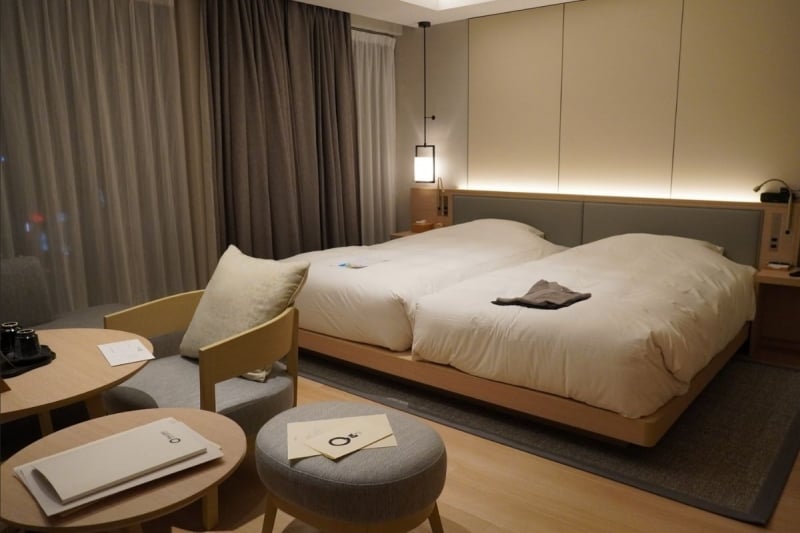
Our stay at ReLabo in Aomori was short, but sweet. The concept here blends wellness and luxury. The hotel started from a hospital group, which explains its emphasis on wellness and health.
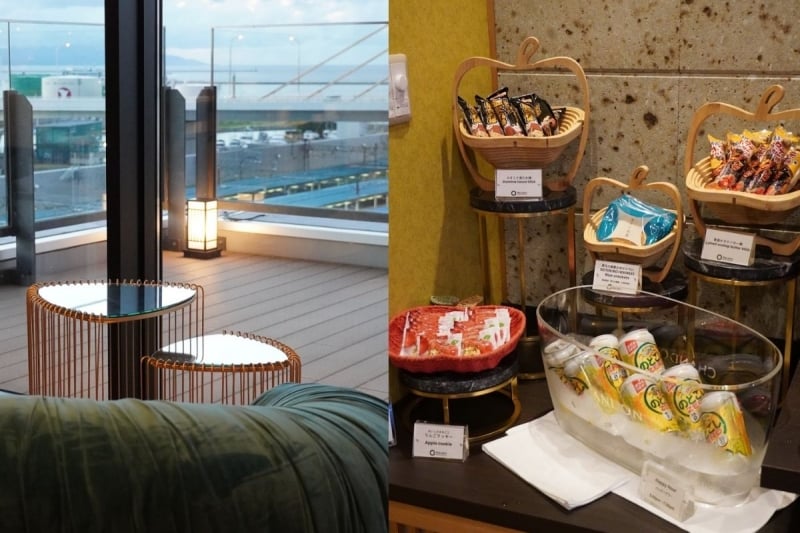
All guests are entitled to access to the lounge, which has a beautiful view overlooking Aomori city as well as a snack bar, and also the public onsen.
What’s unique about this hotel is that it offers integrated health services such as wellness consultations, anti-aging injections, third eye treatments, massages and yoga. The staff in the wellness centre are all trained nurses, and they even have a certified doctor come in on Wednesdays. Other facilities include a beautiful private onsen room that you can book. However, do note that you have to pay extra for these services!

The design of the hotel reminded me of an art gallery, with soft tones and many art pieces lining the walls.
Paired with the wellness gastronomy dinner I absolutely loved, Hotel ReLabo reminded me of a different kind of luxury – the luxury of slowing down, breathing, and just taking in the present moment as it is.
Hoshino Resorts KAI Tsugaru, Aomori
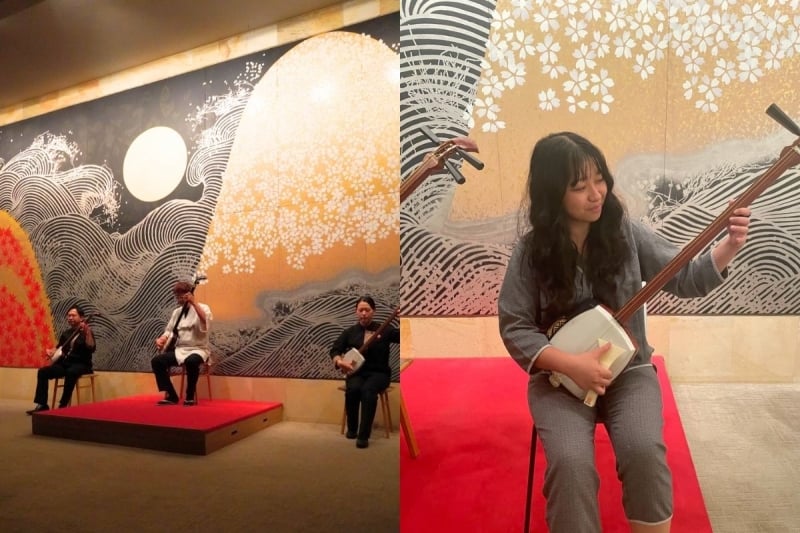
The luxury of KAI Tsugaru was one steeped in culture. The highlight was the live shamisen performance in the evening, where we listened to traditional Tsugaru-style music echo through the hall. I even got to try my hand at the shamisen myself!
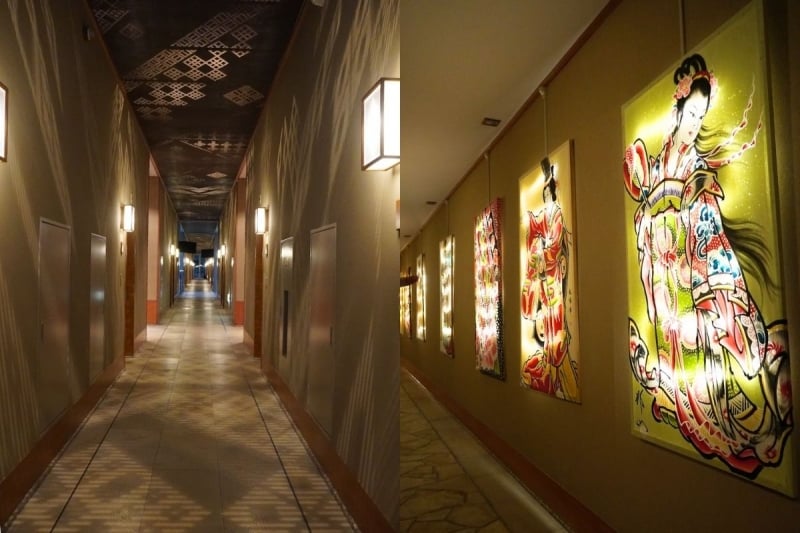
The decor of the place was gorgeous, and I especially appreciated the details using light and shadows. Every corner of the resort was designed with regional pride, from the lacquerware trays to the art on the walls.
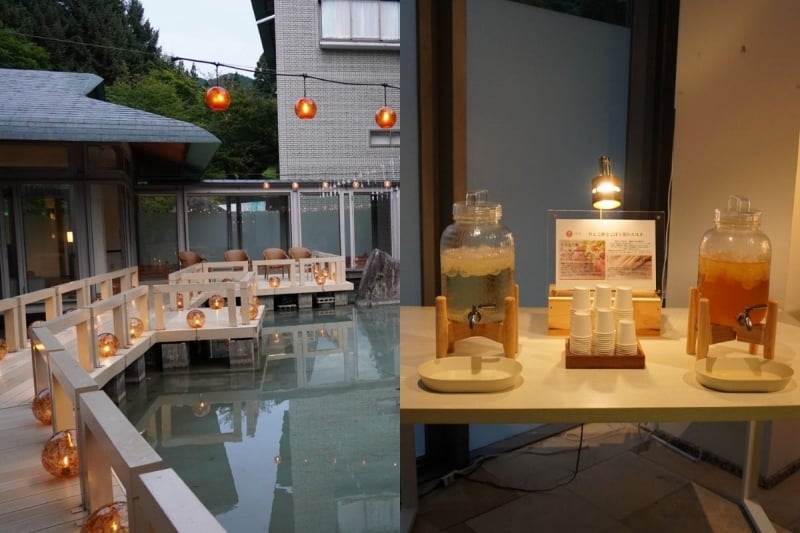
Another highlight of this ryokan was how it had different drink bars offering drinks from apple water to apple vinegar (very characteristic of Aomori!), which are free for all guests. The meals here were also exceptional, from miso scallops breakfasts to the elegant multi-course maguro dinner.
5. “I thought I had to travel fast for a Japan trip to feel ‘worth it’”
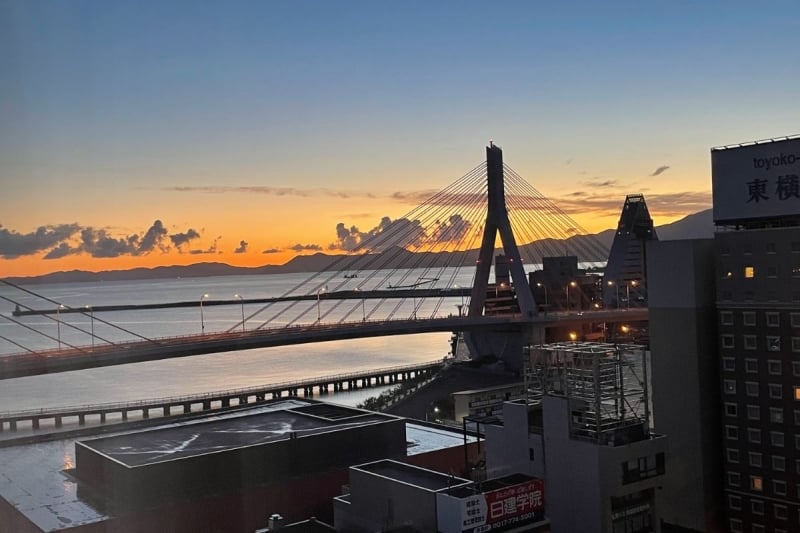
When you’re travelling from Singapore, there’s often this pressure to squeeze in as much as you can. Maximise your leave days, hop across cities, tick off all the must-see attractions. I was guilty of the same when I was rushing through Tokyo, Kyoto, and Osaka with a packed itinerary.
But Tohoku made me slow down. It’s not that there was less to do. In fact, every day was full of new experiences — food I’d never tasted, places I hadn’t heard of, traditions I was just beginning to understand. But something about the rhythm of Tohoku shifted how I moved through it. Rather than rushing to collect sights, I felt like I was learning, listening, and just being present.
Also read: Japan Autumn Foliage Forecast 2025: When & Where to See Autumn Leaves
Even though Tohoku doesn’t shout for your attention, it offers a grounded kind of luxury through its thoughtful meals, sincere hospitality, and deep connection to the land and its stories.
A lot of Singaporeans might overlook Tohoku because it doesn’t fit into the fast-paced image of what a Japan trip should be. But I think that’s exactly why it deserves more attention. If you’ve been to Japan a few times before and are looking for something different or something more immersive, this region is more than worth exploring.
Special thanks to the Japan National Tourism Organisation for inviting me on such a wonderful trip!
All images credited to Ng Wan Xin




